剖宫产术后再次妊娠的精品PPT课件
- 格式:pptx
- 大小:717.67 KB
- 文档页数:17
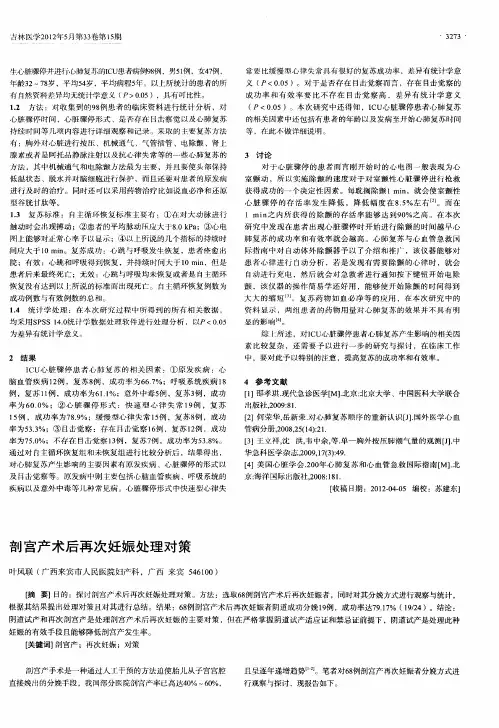
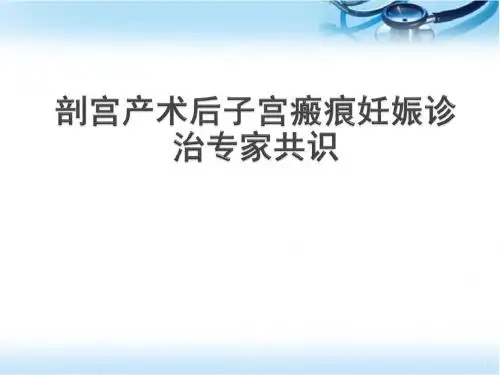
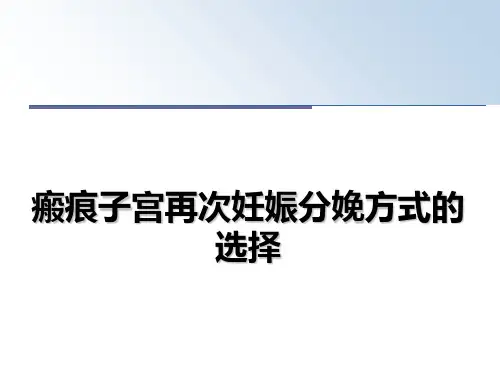
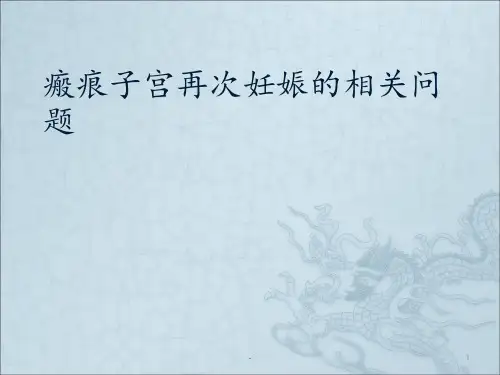
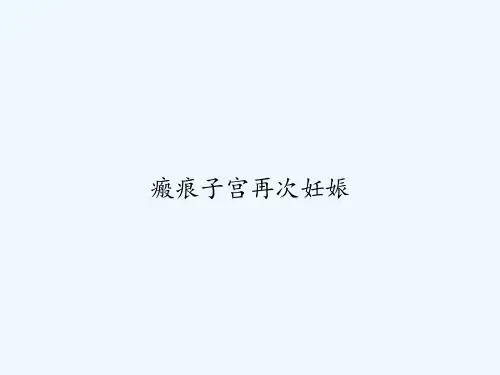
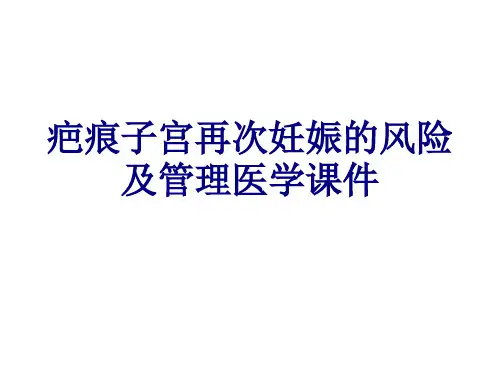
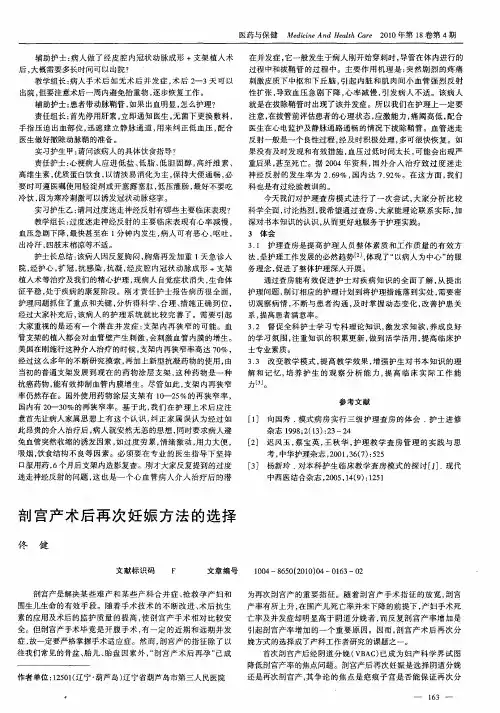

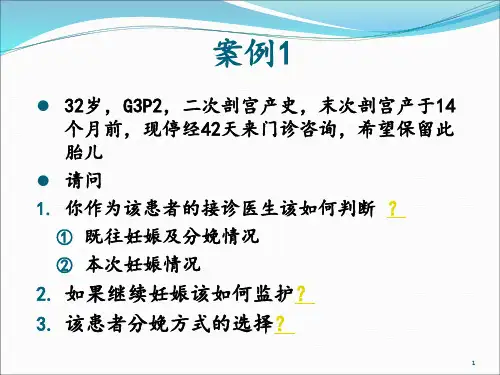

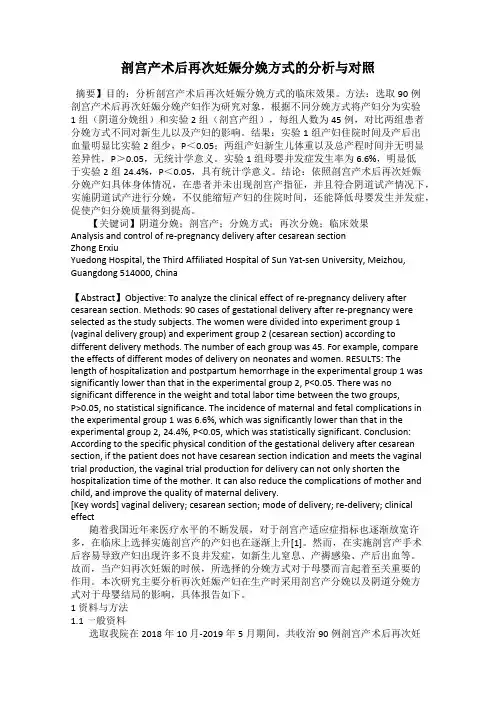
剖宫产术后再次妊娠分娩方式的分析与对照摘要】目的:分析剖宫产术后再次妊娠分娩方式的临床效果。
方法:选取90例剖宫产术后再次妊娠分娩产妇作为研究对象,根据不同分娩方式将产妇分为实验1组(阴道分娩组)和实验2组(剖宫产组),每组人数为45例,对比两组患者分娩方式不同对新生儿以及产妇的影响。
结果:实验1组产妇住院时间及产后出血量明显比实验2组少,P<0.05;两组产妇新生儿体重以及总产程时间并无明显差异性,P>0.05,无统计学意义。
实验1组母婴并发症发生率为6.6%,明显低于实验2组24.4%,P<0.05,具有统计学意义。
结论:依照剖宫产术后再次妊娠分娩产妇具体身体情况,在患者并未出现剖宫产指征,并且符合阴道试产情况下,实施阴道试产进行分娩,不仅能缩短产妇的住院时间,还能降低母婴发生并发症,促使产妇分娩质量得到提高。
【关键词】阴道分娩;剖宫产;分娩方式;再次分娩;临床效果Analysis and control of re-pregnancy delivery after cesarean sectionZhong ErxiuYuedong Hospital, the Third Affiliated Hospital of Sun Yat-sen University, Meizhou, Guangdong 514000, China【Abstract】Objective: To analyze the clinical effect of re-pregnancy delivery after cesarean section. Methods: 90 cases of gestational delivery after re-pregnancy were selected as the study subjects. The women were divided into experiment group 1 (vaginal delivery group) and experiment group 2 (cesarean section) according to different delivery methods. The number of each group was 45. For example, compare the effects of different modes of delivery on neonates and women. RESULTS: The length of hospitalization and postpartum hemorrhage in the experimental group 1 was significantly lower than that in the experimental group 2, P<0.05. There was no significant difference in the weight and total labor time between the two groups,P>0.05, no statistical significance. The incidence of maternal and fetal complications in the experimental group 1 was 6.6%, which was significantly lower than that in the experimental group 2, 24.4%, P<0.05, which was statistically significant. Conclusion: According to the specific physical condition of the gestational delivery after cesarean section, if the patient does not have cesarean section indication and meets the vaginal trial production, the vaginal trial production for delivery can not only shorten the hospitalization time of the mother. It can also reduce the complications of mother and child, and improve the quality of maternal delivery.[Key words] vaginal delivery; cesarean section; mode of delivery; re-delivery; clinical effect随着我国近年来医疗水平的不断发展,对于剖宫产适应症指标也逐渐放宽许多,在临床上选择实施剖宫产的产妇也在逐渐上升[1]。
剖宫产术后一月再次妊娠至足月分娩患者,37岁,因“停经40周,要求待产”于2010年1月18日10时入我院。
G5P1,1999年5月足月顺产1男婴,10岁时夭折。
2007年人流1次。
平素月经规律,末次月经:2009年4月11日。
孕早期无感冒、发热、阴道流血及其它不适。
此次妊娠入院前共行产前检查3次,正常。
入院查体:T36.7℃,P76/min,R18/min,BP120∕70mmHg。
产前检查:宫高32cm,腹围93cm,真、枕左前位,胎心音132bpm。
查血常规:WBC:10.3×109/L,G:61.3%,Hb:104g/L、PLT:224×109/L。
肝、肾功能未见异常,甲肝、丙肝、淋病、梅毒检查均阴性。
于1月22日因“第二产陈延长,胎头下降停滞,持续性枕后位”行剖宫产术,术中娩出一重度窒息男婴,阿氏评分1分,经抢救10分钟无好转,考虑新生儿缺氧时间长,即使存活,后遗症及并发症多,向家属及患者交待病情,患者放弃治疗,15分钟死亡。
产后行抗炎治疗。
7天痊愈出院。
产后53天(即3月17日)行经,此后未采取避孕措施。
6月20日查B超:单活胎,孕3月大小。
医生告知其系剖宫产术后一月余即再次妊娠,间隔时间太短,子宫切口未愈合,此次妊娠风险极大,妊娠过程中可能发生子宫破裂,危机母婴生命安全。
患者及家属迫切希望有一子,坚决不同意终止妊娠,定期产检,并于孕34周住院待产,孕39周(即12月17日)择期剖腹产下一健康活男婴,术后7天出院,42天随访母婴健康。
2 讨论按医疗原则,剖宫产术后应严格避孕3—5年,最少也需2年后怀孕,因有子宫破裂风险。
再次妊娠,子宫增大快,到孕晚期,子宫疤痕因体积扩大而破裂,危及孕妇及婴儿生命。
故剖宫产术后应注意再次妊娠时间,确保母婴生命安全。
此例患者术后不到2月就再次妊娠,风险可想而知,所以提前住院待产一月,幸而妊娠至足月,不能不说是一种奇迹。
一般剖宫产术后不足1年再次妊娠:(1)<12周:根据孕囊位置,采用药物流产的方式,如果是药流不全,在B超介导下进行清宫,直接做人流的比较少,以相对安全些。